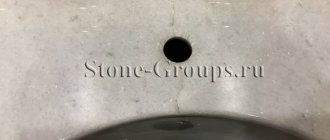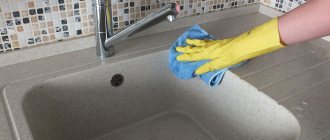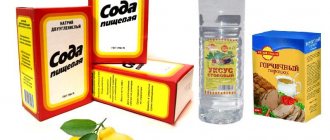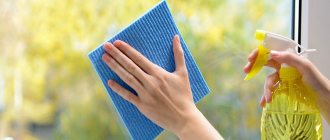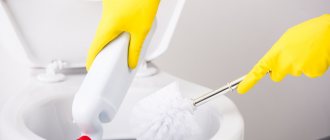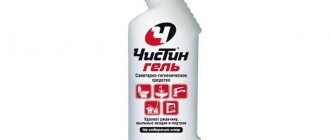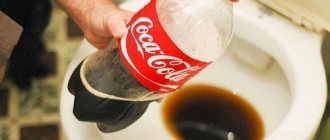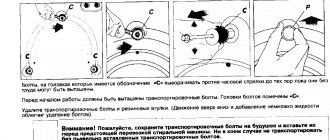May it serve for a long time!
Sinks made of artificial stone have recently become especially popular in the domestic market. This is due to the unique characteristics of the material from which they are made. Artificial stone is produced on the basis of natural mineral components with the addition of resin and coloring agents. It has a dense, homogeneous structure, has high strength and moisture resistance, is resistant to high temperatures, ultraviolet radiation, chemical reagents, and has good hygienic characteristics.
We talked about the pros and cons of artificial stone sinks, as well as the selection criteria, in a previous article. Now we will talk about how to extend the service life of the purchased product.
Differences between acrylic and artificial stone
Having seen a stone sink integrated with a countertop in a magazine, many decide to order one. The market quickly adapted to the needs of customers with limited budgets. Acrylic plastic with a mineral filler began to be called artificial stone. Companies supplying real artificial stone are outraged by such a simple marketing ploy. Because their material is more expensive and durable. Its other names, depending on the filler, are quartz agglomerate, cast marble. Crushed natural minerals make up up to 90% of the material’s weight and determine its physical characteristics. Composition of quartz artificial stone:
Components | Total in composition |
| Natural quartz | 93% |
| Polyester resins | 5% |
| Pigments and decorative fillers | 2% |
Housewives bloggers share tips on how to clean an artificial stone sink. It is difficult to make a mistake with the choice of product, because agglomerate is superior to marble in some respects.
Test results according to the international standard EN – 14617.
physical characteristics | Test performance |
| Density | 2.5 g/cm |
| Flexural strength | 40-45 MR |
| Impact strength | 4.0-10 J |
| Wear resistance | 90-190 mm cube |
| Hardness (Mohs scale) | 6 — 7 |
| Chemical resistance (acid) | Class C4 |
Removing scratches on a sink
Improper use and not very careful care contribute to the appearance of cracks and scratches on the sink, which spoil the appearance and create additional obstacles when washing the bowl.
Serious chips and cracks require professional attention. There are special workshops that carry out reconstruction and repair of stone sinks.
Minor scratches can be repaired at home. The choice of materials and methods of control depend on the surface finish:
- if the sink has a matte finish : apply baking soda to a moistened piece of sandpaper (abrasive sponge), wipe the scratch area with it and rinse with water. Deeper damage is eliminated with sandpaper (first you will need sandpaper No. 240, it needs to be carefully treated with the scratch, and the final grouting is carried out with No. 80);
- if the sink is glossy : small scratches should be treated with liquid with ammonia and wiped in a circular motion with a soft sponge. After this, rinse off the product and wipe the sink dry. Next, you need to apply a special polishing mixture without silicone additives and citrus extract to the surface. Deep damage will have to be cleaned with a grinding machine with different attachments: from coarser (for grouting) to fine (for polishing).
On the household chemicals market there are professional repair kits designed to deal with serious damage. For example, GOI paste based on chromium oxide, epoxy glue, putty. By carefully studying the instructions for their use, you can cope with sink repairs on your own.
Agglomerate in the kitchen
Artificial stone is resistant to damage from hot pans. Manufacturers emphasize this property as an advantage over acrylic products. They claim that you can pour boiling water into sinks made of artificial stone. But we must remember that the surface of the sink can be covered with gelcoat. This is the thinnest layer of polymers that gives a glossy shine. Tips for caring for acrylic stone are also relevant for quartz agglomerate. Although companies do not give categorical recommendations on how to clean an artificial stone sink and what is better not to use.
Acrylic countertops and sinks
In the opinion of an inexperienced consumer, acrylic countertops are even better than products made from agglomerate. The following advantages are listed:
- Look like marble or granite
- The place where the parts of the countertop and the countertop with the sink are glued together is not visible
- You can order a sink of any size
- Very light, no need to reinforce the walls of the kitchen furniture
- Microbes do not multiply on a smooth surface
The material is easy to cut and becomes plastic when heated. A sink made of artificial stone based on acrylic can be made in any shape. There are two manufacturing technologies: the “reverse casting” method and the thermoforming method.
"Reverse casting"
A layer of polymer with filler is applied to the silicone matrix. After hardening, the matrix is removed and the sink is glued into the cutout of the countertop.
Thermoforming
Sheets of acrylic stone are heated, bent and fixed to a rigid form. Allow to cool and harden. Glue the bottom. The sinks are prismatic or cylindrical in shape.
Important! There are known cases when the bottom fell off when boiling water was drained. This is possible if the technology was violated during gluing.
Removing difficult stains
The presence of stains, stains and greasy deposits significantly impairs the attractiveness of any product. In addition, such defects can negatively affect the internal structure of the material. It is easy to cope with pollution using traditional methods.
When removing fresh stains, a soap solution is useful. Laundry soap is grated and dissolved in a large amount of water. Wipe the surface with the resulting mixture until completely clean. After cleaning, wipe again with clean water and wipe dry.
Advice. Instead of laundry soap, mild liquid soap will be useful.
Soap solution is an excellent solution for removing any stains.
Mustard powder will help remove old stains. Pour a small amount of food ingredient with warm water and stir until a paste is obtained. Wipe the table with the resulting mixture until the dirt is completely removed. When finished, wipe again with clean water. A gel-like toothpaste can also deal with old stains. The process is carried out in a similar way.
Attention! When working, use a soft sponge or rag.
Mustard powder will help remove old stains from the surface.
Kitchen products made from quartz agglomerate
The agglomerate is produced using fairly complex technology in a factory. Stages of the technological process: vacuum vibrocompression, catalytic reaction of polyester resin hardening at certain temperatures. It is believed that a countertop made of artificial stone is more prestigious than one made of acrylic. Sink sinks made from agglomerate are produced by well-known companies. When choosing a sink and stone countertop slab from different manufacturers, it can be difficult to get a perfect color match. Designers take this into account when creating a design project.
You may be interested in: Kitchen sinks
Due to its high strength, quartz agglomerate is cut only on special machines in the workshop. On-site adjustment is difficult. To securely fasten a heavy stone sink , you need to correctly calculate the strength of the cabinet walls.
When is a steel sink preferable?
A disposer, or food waste grinder, is installed instead of a siphon. During its operation, the entire system, including plumbing pipes and countertops, experiences vibration loads. This is the most insidious type of mechanical influence. It is especially dangerous for sinks made of acrylic plates glued at the ends. An agglomerate sink is more resistant to vibrations. Experts still recommend strengthening the structure during installation. Or create an interior in which stainless steel looks organic. Everyone knows how to clean a stainless steel sink.
What is the difference between artificial stone and acrylic sinks?
There are some minor nuances in caring for agglomerate and acrylic countertops.
First we need to clear up the confusion created by marketers. From a distance, both artificial materials resemble natural stone and look great in the kitchen interior. Before you wash a “stone” sink, you need to make sure what you are dealing with. For example, if the kitchen set was inherited from the previous homeowners.
Acrylic-based artificial stone | Agglomerate |
| Warm to the touch | Cools to the touch |
| Glued onto a chipboard backing | Without backing, plate thickness 2-3 cm |
| Seams and joints are not visible | Joints are visible up close |
Boiling water of 100 degrees C will not cause damage to a sink and countertop made of agglomerate. The manufacturers themselves do not recommend pouring boiling water into an acrylic stone sink.
A case from one's life. Following this advice, the housewife poured the pasta and potatoes into a special metal basin. It stood next to the sink right on the acrylic countertop. After some time, a cloudy spot appeared under the basin.
Remove limescale and stains
Limescale and stains appear on sinks made of composite materials due to irregular maintenance. To remove such contaminants, it is recommended to use the following methods:
- Once a week, fill the container to the brim with water and add 2-3 teaspoons of bleach to it. After 20 minutes, the solution is drained, the surface is washed with water, and dried.
- Once every 2–3 weeks, the sink is treated with household bleach. To clean, take one part bleach and dilute it in 4 parts water. Spray the surface with the solution and wash off with water after 3–4 hours.
- A melamine sponge helps remove stains of various origins. The sponge is moistened and cleaned with the foam of dirt formed on it. Then the treated area is washed with water.
Chemical composition of contaminants
Stains on an artificial stone sink appear over time. Although both materials do not have pores on the surface and are inert to food acids. The nature of this phenomenon is the formation of porous deposits.
You may be interested in: Classic kitchen sinks
When each drop of water dries, it leaves behind a layer of “sedimentary rock.” This is called limescale. In addition to calcium, it also contains other salts. The chemical composition is different everywhere. This permanent film of minerals absorbs rust, colored vegetable juices, grease and other substances from food debris. The surface color turns from white to dirty yellow. To whiten a sink, you need to remove plaque. Acrylic stone sinks cannot be cleaned. Hard brushes, powders, even ordinary soda will leave micro-scratches. Any, even the cheapest, liquid or gel for removing limescale will do. It is advisable to purchase a cleaner for “artificial stone countertops and sinks.”
Features of the material
The presented sinks can be made of artificial or natural stone. The first option is a composite material based on 80% stone chips and 20% acrylic resin. Among its advantages, durability, maintainability, and heat resistance should be highlighted.
Natural stone fascinates with its graceful textures and brilliant mica flecks. The material itself is durable and environmentally safe. However, natural stone has a porous structure, and therefore requires increased attention in terms of care.
To extend the service life of the product, it is necessary to use special water- and grease-repellent impregnations. They form a protective film on the surface and close the pores of the stone.
Fighting stains
Every housewife has her own proven means for keeping the kitchen clean. And your secrets on how to clean your countertop to a shine in a matter of minutes. The main thing is that the cleaning product does not contain a lot of acids and chlorine (no more than 5%). There is a simple tip on how to clean your sink with maximum effect. The surface is first wiped dry. Then spray the liquid cleaner and leave for a few minutes. Wipe again with a dry sponge and wash with clean water. To protect the white sink from frequent cleaning, it is recommended to wipe it with a sponge and detergent after each dishwashing. A melamine sponge has worked well. A dark-colored artificial stone sink will have to be washed and wiped even more often than a light-colored one. The trace of every drop is visible on the dark glossy surface. There are no specific recommendations on how to clean a stone work area the color of malachite or black marble. Dark stains will be less noticeable, but you will need more microfiber cloths to wipe off light stains.
General care recommendations
Every time you use
- Do not leave wet towels, sponges, etc. either in the sink or on its wings. Limescale is actively forming underneath them, which you need to avoid.
- Wipe off water from the sink after use. Ideally, this should be done after each use. The less moisture there is on the surface of the bowl, the lower your chances of encountering plaque.
- Avoid dropping heavy objects inside the sink, especially in the central area.
- When using drain cleaners, make sure that they go directly into the drain and do not remain on the surface of the sink. Contact with them may not have a very good effect on the appearance of the bowl.
spring-cleaning
It’s not easy to clean your kitchen countertops from old grease and stains. Acrylic stone cannot be scraped. Therefore, you need to be patient and apply the detergent several times. “Grandma’s” products are also suitable for cleaning artificial stone. They knew how to clean a mixture of soot and grease without the assortment of a household chemical store. In the last century they used:
- Mustard powder
- Soda slurry with hydrogen peroxide
- Any alcohol solution, such as old cologne
- Lemon acid
- Toothpaste
- Sodas containing phosphoric acid (this method was discovered later)
Home remedies can be applied and left on for any length of time. They dissolve grease without harming countertops. All delicate substances are also suitable for washing. Dirty grease deposits on an agglomerate countertop can be washed with a brush and a sponge with powder, or you can even scrape off the soaked grease film with a plastic spatula. You can use concentrated grease solvents, but do not leave them on surfaces for long. It is recommended to clean the stone surface of the sink in the same way as acrylic, using liquids and gels.
Use of household chemicals
Various products are available to care for granite surfaces. They are easy to use and gently clean the composite sink. As a rule, they are used according to the same scheme: applied to a sponge, distributed over the walls and bottom, left for a quarter of an hour, and then washed off. If there are stains on the surface, scrub them with a sponge before rinsing off the composition. The most popular products: “Sif”, “Chistoff”, Blanco, Amway and others.
For periodic cleaning, you can use tablets designed for dishwashers. Dissolve the tablet in 3 liters of water, moisten a rag with the liquid, and wipe the surfaces. After 15 minutes, wash off. This helps remove lime deposits and some other contaminants.
With proper care, a granite sink can last up to 15 years. Regular cleaning, timely removal of dirt and compliance with operating rules will help keep it in its original form for a long time.
Clean every day
The stone sink in a model kitchen needs to be cleaned once a month. But if you remember how to care for a beautiful surface, cleaning will be required much less often. Daily care of an artificial stone sink is simple:
- Before draining any liquid or boiling water, fill the bottom with cold water
- Wash off wine and juice stains immediately
- Do not leave dirty dishes for too long
- Do not leave drops of water - wipe the area dry each time you use it
- Wash with liquid detergents, gels and pastes without abrasive
Terms of use
Of course, you need to know how to clean a capricious stone sink. But it is equally important to follow simple instructions for its use. Despite the fact that stone plumbing has a fairly high density and strength, there are still a number of recommendations for its careful operation.
- You should be careful with sharp and heavy objects when washing them. For example, even an unintentional drop of a knife can cause a chip or crack.
- Products made of ceramic material are also extremely sensitive to temperature changes - it is worth washing dishes exclusively with warm water, smoothly switching from cold to hot. It’s also not a good idea to put pots and pans in the sink straight from the stove.
- You cannot pour boiling water into such a sink without turning on cold water at the same time.
- It is not recommended to use the surface as a cutting board - over time, defects will appear on it that will be difficult to remove.
- It is not advisable to keep dirty dishes in the sink for a long time. This is especially true for a beige or white stone sink - it will quickly become covered in various shades of yellow.
Tip: if you use a cleaning agent in powder form for a composite surface, then moisten it with water until it becomes a paste - this way you can reduce the abrasive effect on the plumbing material.
Special contaminants
Markers, felt-tip pens, ballpoint pens
How to wash countertops painted with children's markers? You can test whether soda actually removes alcohol ink. But vodka or alcohol is safer. Many interiors have become victims of felt-tip pens, so special cleaning products are produced to remove the marks. Chlorine-containing compounds and bleaches deal with stains quickly. But before you clean the art, you must carefully read the instructions. Do not leave the composition on the stains longer than the specified time; it is better to repeat the procedure later.
Rust
Rust is washed off with detergents labeled “for acrylic bathtubs.” They interact not with iron oxide, but with a precipitate of calcium and salts. Rust does not settle on smooth walls; it stains limescale.
Dye
Cleaning the countertop in the kitchen after renovation is easy, since the paint does not stick well to acrylic. Soak stains of oil or water-based paint with warm water and carefully scrape off with a plastic or wooden tool. Use solvents carefully, first check in an inconspicuous place.
Oil and fat
To clean a stone work area from spilled vegetable oil or greasy sauce, simply absorb the substance with paper napkins, then wash off the greasy stain with soapy water. Advice! With regular use of laundry soap, a cloudy film of fatty acids forms. It can be easily removed with window glass cleaner.
How to choose the right product
Not all products and tools can be used to clean composite kitchen sinks. Products labeled “for artificial and composite materials” are best suited for this purpose, but you can also use improvised means. They should be:
- gel or creamy, without abrasive particles;
- without alkali, chlorine, phosphates, methylene chloride, acids.
Abrasive products lead to scratches, and a rough surface accumulates dirt faster. If you have to use regular cleaning powder, it is dissolved to form a paste.
How to care for cloudy acrylic surfaces
Countertops and sinks may lose their shine after many years of use. The surface of acrylic inevitably becomes covered with microscopic scratches, and more and more kitchen residue accumulates in them. How can you restore shine to acrylic marble? To polish with your own hands, you need a special paste with a soft abrasive. It is applied to a cloth rag and polished for a long time in different directions. The final gloss is applied with clean cloth. If the result is not satisfactory, you will have to invite a specialist with a grinder. Acrylic stone will withstand several restoration cycles, depending on its thickness. This is its advantage.
Remove scratches
To mask defects, use one of two options - sandpaper and a polishing machine. The second option helps hide chips and scratches. Manufacturers recommend using the device regularly. Glossy sinks of rich dark color require such treatment. On such surfaces the slightest defects are most noticeable. Sinks are sanded once a year.
See also
TOP 17 best remedies for how and how to wipe a handle off a sofa at home
Sandpaper and putty
A person can do minor repairs on his own. To do this you need to do the following:
- The damaged area is washed and degreased.
- The areas are treated with sandpaper and filled with a special compound.
- The surface is sanded again after drying.
- At the last stage, the surface is treated with a special paste.
For minor scratches, polishing with sandpaper will be sufficient. Shallow chips are treated with fine-grained sandpaper. To eliminate deep ones, you will need coarse-grained and fine-grained ones alternately.
Pros and cons of cleaning products
Comet, Pemolux, Domestos and Shumanit whitening gel paste are types of products that cope with unpleasant, difficult-to-remove stains and help prevent yellowness.
Pros of cleaning products
Let us highlight the following positive properties of the cleaner:
- eliminates any type of dirt and guarantees easy removal of stains during subsequent care;
- does not contain acetone;
- environmental friendliness, health safety (allowed for use in an apartment);
- to improve the appearance, you can use fine sandpaper and other aggressive tools, including a melamine sponge;
- sensitive coating cannot be treated with chlorine (whiteness will damage the surface, and disinfection is best carried out with gentle means); it is easy to scratch, it is afraid of alkali and falling - to clean such areas, you will need a cloth and a recipe using vinegar essence and running water;
- household appliances and surfaces will last longer if you prevent or polish scratches left by large frying pans with a disinfectant before using abrasives;
- To improve the performance characteristics of dishwashers, coffee and tea appliances, in the absence of prohibitions, it is allowed to clean them with these products in accordance with the manufacturer’s instructions. But before work, you need to check the car for severe damage;
- suitable for composite. If necessary, problem areas with ingrained dirt can be treated with any product. To do this, use a sponge with a small amount of product to thoroughly rub the contaminated area with light movements; you can also use a soft towel;
- prevents the appearance of microorganisms;
- the surface after cleaning with such means can withstand temperature changes due to hot and cold drinks, ingress and prolonged exposure to moisture due to the fact that a tap is nearby (they are not harmed by coloring compounds, impacts with very sharp objects and prolonged contact with fat);
- For maximum effect, scrub the stains until a small, barely noticeable area remains. Heavy contamination requires active cleaning, as this is the only way to eliminate all defects.
- After cleaning, at the end of the work, it is recommended to polish the surface. Work related to the care of countertops can only be called effective if all recommendations are followed;
- To easily restore the original appearance of the interior layer of the tabletop and restore its stability, achieving an ideal condition, just dissolve the product in water and wipe the surface with a cloth soaked in it. After such procedures, the countertops will be like new.
Cons of Cleaning Products
Despite the impressive list of advantages, these products also have a drawback: they need to be provided with proper storage and subsequent care, protected from direct sunlight, and ensure that splashes do not get into the eyes during operation. Household chemicals cannot cope with deep damage, so you should avoid them by using the usual solutions and means of protection during operation, for example, special cutlery, silicone mats, coasters.
Popular folk methods for cleaning stone sinks
Stone sinks and sinks, despite their name, which is associated with strength, are not particularly practical and resistant to the influence of various factors. Unlike stainless steel plumbing fixtures, products made of polymer-based composite material are not resistant to temperature changes, staining by coffee, tea, juices of berries, vegetables, and fruits. They are susceptible to chipping and cracking under heavy impact. If the faucet leaks water due to a malfunction, rusty streaks can become “tightly” embedded in the texture of the artificial stone and are difficult to remove.
Inconveniences can be avoided by following simple rules for using stone sinks. You can clean plumbing fixtures that look like granite stone or marble products using household chemicals or traditional methods.
You can choose a product for cleaning stone sinks on store shelves or use improvised products.
Baking soda is a universal substance used by housewives in many areas of everyday life. If you add a small amount of water to the white powder and rub the surface of the sink with the resulting slurry, you can wash it from dark stains, soap stains, salt deposits, and greasy deposits. When rubbing the sink with sodium bicarbonate, it is important not to overdo it, so as not to leave traces of abrasion or scratches.
Mustard powder does an excellent job of removing grease from kitchen plumbing fixtures. It can be used in pure form or mixed in equal proportions with soda. A paste is prepared from the powder with warm water and applied to the stained areas, rubbed lightly with a sponge, and washed off with running water.
Citric acid is an organic chemical compound that even delicate surfaces are not afraid of. Dark areas due to exposure to coffee or tea, yellowness, salt deposits, drips and stains can be removed by rubbing the problem area with a slice of citrus fruit. On more stubborn stains, you can leave the lemon juice for 10-20 minutes and then rinse the surface with warm water.
Crystalline powder with a sour taste will dissolve limescale deposits and whiten the yellowed surface of a stone sink. To do this, you need to close the hole in the sink, fill it with warm water to the brim, and pour in the contents of the bag (50 g). To dissolve faster, mix citric acid in water and leave the resulting solution in the sink overnight. In the morning, the water is released, and the product is rinsed with clean water and rubbed with a dry soft cotton cloth.
Table vinegar 9% or an aqueous solution of acetic acid 70-80% will help clean an old stone sink from dark stains and lime deposits. Vinegar 9% is diluted with water in a ratio of 3:1, and acid - 1:10. A sponge is moistened in the prepared solution, and the rough side rubs the area of contamination. At the end of the procedure, the plumbing fixtures are rinsed with warm running water.
We are talking about Coca-Cola, which copes well with rust and salt deposits. The drain hole of the sink is closed with a plug, a drink is poured into the product and left for half an hour. The edges and top of the sink need to be moistened with a sponge. After time, the liquid is drained and the surface is washed with water.
- Cleaning the bathtub with soda: which one to choose and what to combine with it
- Review and effectiveness of traditional methods of safe floor disinfection
- Effective crystal care products
Toothpaste and powder are great alternatives to cleaning products. They will remove dirt and refresh the product with a pleasant aroma. A little paste is squeezed onto a sponge or powder is sprinkled, after which the problem area is rubbed and then washed off.
